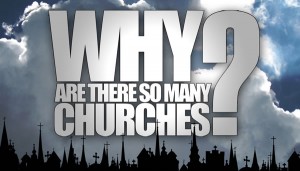One of the many themes throughout the book of Revelation is the concept of one’s city. And though the word appears often throughout the book (thirty times in the ESV), all but eight instances are concentrated in John’s sixth episode. On one hand, there is “the great city that [spiritually] is called Sodom and Egypt, where [the] Lord was crucified,” and where the blood of many would flow (Rev 11:8, 13; 14:20; 16:19 ESV, see margin). And on the other, there is “the holy city,” which would be trampled for forty-two months, but would ultimately triumph as “the city of my God, the new Jerusalem, which comes down from my God out of heaven” (11:2; 3:12).
Having witnessed the terrifying judgment of God upon his enemies in Revelation 16, several questions naturally arise in the mind of the reader, all of which revolve around these symbolic cities: Are these prophecies really fulfilled in the fall of Rome? Does this mean that Christians are to blame for the demise of the Empire in the West? And when does the book of Revelation actually talk about us today—what about the end times? We’ll take a look at these first two questions this week, and the others (Lord willing) in the week to come.
That Rome is the subject of John’s visions is clear from the description of “the great prostitute” in chapter 17. She is identified as “the great city that has dominion over the kings of the earth” (17:18); she sits upon seven hills (17:9); and she reigns over all nations, leading them into lewd and luxurious lifestyles of sin (17:2, 4, 15). Additionally, the description of the beast she rides upon parallels that of the first beast in chapter 13, which we have previously identified with the Roman principate, personified as Domitian. He is “full of blasphemous names” (17:3; 13:5-6); he has “seven heads and ten horns” (17:3, 7; 13:1); he has fallen in defeat, but regained his former strength (17:8, 11; 13:3); and he is the primary cause of persecution for Christians in the province of Asia at the end of the first century (17:14; 13:7-10).
This is not, though, all old information. John is told that the seven heads are “also seven kings,” plus an eighth (Rev 17:10-11). Ten other kings (probably ethnic rulers throughout the empire) will also make an appearance, sharing authority with the beast and joining in the war against the Lamb, but later turning on the city herself (17:12-17). The number ten appears to be used in the same symbolic sense that Daniel used centuries before (Dan 2:35, 44), but the interpretation John is given of the seven kings (and the eighth) seems to argue for something more specific. It is possible, for example, that the first five kings represent the Julio-Claudian emperors (Augustus, Tiberius, Calligula, Claudius, and Nero); the fall of the beast refers to the civil war of AD 68-69 (in which Galba, Otho, and Vitellius vied for power); and the remaining three kings represent the Flavian dynasty: Vespasian “is” (he is still “on the throne” in the eyes of the senate), Titus is “to come” (always his father’s right hand and heir apparent) and the eighth is Domitian, who “goes to destruction” (17:11).
Whether taken literally or figuratively, however, what is clear is that Domitian (“soon;” Rev 1:1, 3; 22:6, 7, 10, 20) and Rome (eventually) would experience the Lamb’s judgment as a result of their systematic corruption. Though completely ignorant of the Lord’s designs, by the time the seven churches received the book of Revelation, the Romans knew Domitian’s time was coming. In AD 96 (within only months of John’s writing), Domitian was stabbed to death in his own palace by political opponents and members of his own household, and “the senate ordered that every reference to him on public monuments should be erased” (Freeman 485).
What the Romans did not see coming (or perhaps merely refused to acknowledge) was where their own (not-uncommon) pattern of sin and bad policy were heading. On the policy front, Rome outsourced her security to the very peoples she had been fighting, and when she no longer wanted to pay what the barbarians were asking, they made sure she wouldn’t forget it. In 410, the Visigoths carried out the first sack of Rome in 800 years. “It was a move which had a devastating shock effect on the Roman world, far beyond its importance as an act of destruction. Rome was no longer an eternal inviolable city” (Freeman 543, 611; see Rev 9:13-19; 16:12-16). And it only got worse from there: administration eroded, soldiers abandoned their posts when their pay failed to arrive, and the Germans simply moved south. By the time the senate dissolved in 580, Rome had shrunk from a metropolis of 100,000 people to no more than 40,000 (see Freeman 615, 616, 624; see Rev 16:19).
But as Revelation makes clear, Rome’s bad policy was only the means to her judgment; it was Rome’s sins that ultimately brought about her downfall. And for Christians (at least) this should not have been surprising, because God had done the same thing to Babylon and Tyre (and Sodom, Egypt, and Jerusalem, for that matter). Like them, Rome became an unclean haunt (Rev 18:1-3; Isa 13:21-22), she received a double portion for her sins (Rev 18:4-8; Isa 40:2), and her mirth was turned to mourning (Rev 18:9-24; Isa 47:7-9; see too Eze 27:32-36; Jer 51:49, 63-64; 25:10). Her persecutions, her fornication, her hedonistic life of luxury, and her blasphemous hubris had finally caught up with her (Rev 17:1-5; 18:3-8).
Edward Gibbon was only half right: Christianity didn’t cause the collapse of the Empire; Rome fell because of her own sins. Augustine, however, was much closer to the truth:
Augustine’s last great work, The City of God, was prompted by the sack of Rome by the Visigoths in 410 . . . . Although the physical damage was not immense (and the Christian Visigoths [actually Arians—JB] left the city’s churches untouched [Rev 14:9-12?]), the psychological shock certainly was. It seemed as if the world as all had known it was at an end. Much of the book is concerned with pointing out the failure of traditional Roman religion to save the city or provide anything more than a self-glorification of the state. . . . Augustine argued that the true ‘city’ was, instead, that inhabited by the believers loved by God, a community which extended from earth into heaven. An earthly city, even one so great as Rome, was only a pale reflection of the heavenly one and it was to the heavenly city that the aspirations of men and women must be directed. (Freeman 603)
The following files are now available for free viewing and download:
Attachments
- 07 Slides: The Two Cities (Rev 17:1-22:5)
Audio Recordings
- Week 31: The Seven Bowls and Two Cities (16:10-17:18)
- Week 32: The Two Cities, Part 1 (17:1-18)
- Week 33: The Two Cities, Part 2 (18:1-24)
Works Cited
- The ESV Study Bible. Ed. Lane T. Dennis & Wayne Grudem. Crossway, 2008. Accordance.
- Freeman, Charles. Egypt, Greece and Rome. 2nd Ed. Oxford, 2004. Print.
- Gibbon, Edward. The History of the Decline and Fall of the Roman Empire. 1776-1789. Ed. Rev. H.H. Milman. 1845. MobileReference. iBooks.
- Summers, Ray. Worthy is the Lamb: An Interpretation of Revelation. Nashville: Broadman, 1951. Print.
Cross-posted from In His Image.





